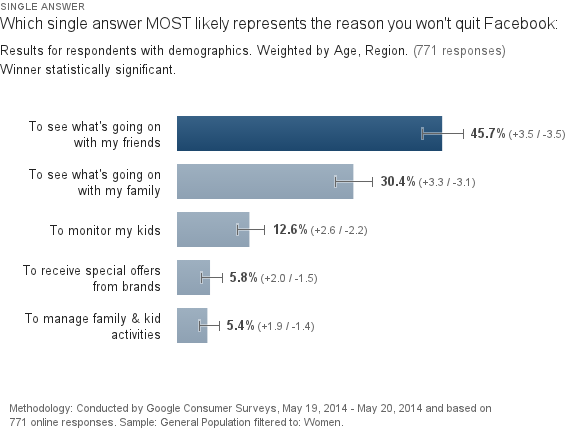The Unspoken Truth about Social Media Engagement Strategies
Looking to reach and influence customers through social media?
Just be sure your mission aligns with reality first.
A recent Wall Street Journal article, “Social Media Fail to Live Up to Early Marketing Hype” finally laid bare what I’ve been preaching for a while: social media marketing should not be a numbers game; it should be about being and creating authentic, real connections. This goes as much for brands as it does for individuals.
To excerpt some pieces of this article that resonated with me:
“Companies have invested money into social media sites, but brands are learning that racking up fans and “likes” is not the same as minting sales.”
“Another reason companies are looking beyond fan numbers is that the numbers are easily gamed. Researchers say many fans are fake, or automated, accounts designed to inflate numbers.”
In reference to findings released June 23, 2014: “Gallup says brands assumed incorrectly that consumers would welcome them into their social lives. Then they delivered a hard sell that turned off many people.”
“‘Engagement is key and is something that can in turn further grow your audience,’ says Ross Hoffman, Twitter’s director of brand strategy. ‘The onus of good content is on the marketer…’.”
More On That Gallup Survey
Gallup’s findings about social media’s influence on consumer behavior – including purchasing behavior – affirms of my own related research, albeit mine was limited to Facebook only and I filtered for women. Since Facebook is the world’s largest social network and women represent half the population, I think it’s a pretty good bellwether for this assessment. I worded my question a little differently, asking respondents what their top value in Facebook was . . . and it was not to influence purchasing decisions vis-à-vis brand offers. The correlation I’m deriving here relies on the fact that of all the activities brands can do to drive purchase intent through social media, making special offers available to fans and followers has proven the most successful.
I have to wonder if the Gallup poll elaborated with examples of the actual “social media” respondents should be reacting to, because in my experience (and validated by some informal polling of my own), younger millennials don’t necessarily even know or use the collective term “social media” in their vernacular but instead call the platforms by their actual names: Facebook, Twitter, Instagram, etc.
I even asked a digital marketing college student I know, “Before you took your digital marketing class(es), did you even refer to social media as ‘social media’ or is that more of a clinical term for marketing folks (in your opinion)?” He responded,
“Definitely not. ‘Social media’ is not a term used colloquially by my generation, like ‘Hey man, did you check out my social media post the other day?’ The line is too blurred at this point to use such a blanket distinction anyway. I couldn’t actually tell you what ‘social media’ means without looking it up (save the obvious examples like Facebook and Twitter).”
Definitions of Influence
Not that I disagree with Gallup’s conclusions about millennials. Other research has pointed to what persuades milliennials. A January 2014 Crowdtap/Ipsos study found that millennials are most influenced by content created by their peers (“user-generated content”). This kind of content informs purchasing decisions up to 59 percent of the time, is 50 percent more trusted by milliennials than other media, and peer reviews slightly exceed professional reviews when it comes to product information.
So why do so many brands equate social media with the ability to influence? I think it’s a matter of misinterpretation:
Social media does not equal word-of-mouth
Word-of-mouth marketing (sometimes referred to as viral marketing) can be a by-product of social media interactions, but they certainly aren’t interchangeable terms. A word of mouth (WOM) recommendation is the Holy Grail, any which way a company can come by it, social media or otherwise. Google recently released findings of a six-month survey of consumers who purchased major category products and found that WOM recommendations influenced 74 percent of buyers.
Brands that go into social media marketing thinking they can benefit from word of mouth recommendations, however, should think again. Why? Because most people bridle what they recommend for only “the real deal.” In giving out a recommendation, people’s word – their reputation – is at stake and most people’s reputations aren’t for sale. For a brand, the consumer’s WOM recommendation has to be earned, and generally that’s through real-world experiences with that product or solution, not some trumped-up concept disseminated via a social media outlet. And certainly, a “Like” does not carry the same clout as a true, authentic recommendation.
This is why the Gallup survey found the conclusions it did. Social media just creates intangible experiences, and (with the exception of intangible or experiential products like music or online video) it’s very hard to replace the physical experience of interacting with a product when it’s that very interaction that leads to the WOM recommendation. On social media, brands can encourage these kinds of recommendations, but it’s very hard for them to influence purchasing behavior all on their own.
Product Reviews Do Deliver Word of Mouth Potency . . . But That’s Not Social Media Either
Product reviews, particularly online product review, do carry tremendous weight these days – almost nearly as much as professional reviews, as the Crowdtap/Ipsos study mentioned earlier pointed out. They carry almost as much trust-power – 46 to 68 percent, depending upon which study one looks to — as recommendations from people in positions of trust like friends and family.
And while you might not know or ever know the person writing the online product review, that doesn’t alter the fact that the manufacturer or service provider still had to earn that consumer’s trust in order to garner a favorable review. (I caveat this statement with a recognition that less scrupulous companies still do try to game the system by mass self-postings or buying favorable reviews.)
These reviews may be incredibly powerful, but there was really no social engagement to earn them. Earning positive reviews and recommendations from inner circle people harkens back to simple basics, not engagement gimmicks: products and services that deliver upon consumer expectations of quality, price, and usefulness. The term that used to be used to describe this is also simple: Value.
Value, Brand Relationships and Reality
Thus, we get to the crux of the matter. As expert and author Ted Rubin so succinctly writes when defining his metric, “Return on RelationshipTM“:
“ROR is the value (both perceived and real) that will accrue over time through loyalty, recommendations and sharing, and is used to define and educate companies, brands, and people about the importance of creating authentic connection, interaction, and engagement.”
I believe this principle to be true . . . but truly implementing and seeing results from it is an entirely different story altogether, and here’s why:
- A lack of patience. As Rubin points out, ROR requires a long-term commitment, and today’s company executives and stockholders/investors don’t give programs like these the time they take to bear fruit. I talk about this a bit in my post, “Can Pragmatic Be Sexy?“
- Misaligned definitions of “engagement.” Just what counts as an “engagement”? Is it merely Liking or Following a brand? Is it eliciting some kind of specific reaction from a user? Is it a measurement of time or number of times a single user interacts with that brand over a defined timeframe? Is it entirely something else altogether? According to eMarketer, 80 percent of brands now have some kind of social media metric in place, but what metrics are being used varies widely and the word “engagement” isn’t even cited. If “engagement” doesn’t bear a universal standard that translates the same across all companies and all users, how can the expectations be the same?
- A lack of authenticity. A long-touted cornerstone of social media, authenticity has mostly been elusive when it comes to mainstream brands, hence a real and growing mistrust among consumers, particularly when it comes to believing what brands claim in their advertisements
- Real relationships can’t be outsourced. If I want to be your friend, it’s you I want to be friends with, not your life coach or housekeeper. Social media management takes a great deal of time and talent, no easy feat for a brand without the existing internal bandwidth or capabilities. As a consequence, some brands choose to outsource their social media. When they do this, however, they are essentially turning their relationship with you over to a third party. That’s fine for brands not really looking for ROR, but it certainly changes the feeling of that relationship once it becomes evident. It feels a lot like inauthentic, and then we’re back to my previous point.
- Brands can hire more time; people can’t. To me, this is the real kicker, the real “dirty, little secret” of social media engagement strategies: Of the thousands of entities out there seeking to engage with consumers through social media, how much time per day is any one (actively employed at a full-time job) individual actually even able to engage?! One hour? Two?? How long are these “engagements” supposed to last in order to be judged successful by the companies doing the engaging, and therefore how many successful engagements can one individual even conduct per day? The overall percent of across-the-board real consumer engagement for all combined companies using social media has to be minuscule. Even if I’m an extremely devoted and loyal customer, I can only give Brand X so much of my time on any given week, on any given day.
What’s A Brand to Do?
As the Wall Street Journal article pointed out, businesses have started to adjust their thinking about media and the success metrics they use to measure social media. I think further re-alignments have to take place. Companies need to consider the ways in which social media can be and should be most effective for them, and stop kidding themselves about “engaging” with their customers. Social media works great for customer service, for building an email-alternative direct communication and promotions channel with customers, for business intelligence, for conducting soft market research, for consumer-generated publicity, and even collecting creative assets to use for other marketing purposes.
I would describe none of these, however, as real “engagement” so let’s just stop calling social media strategies — or their objectives — that.










